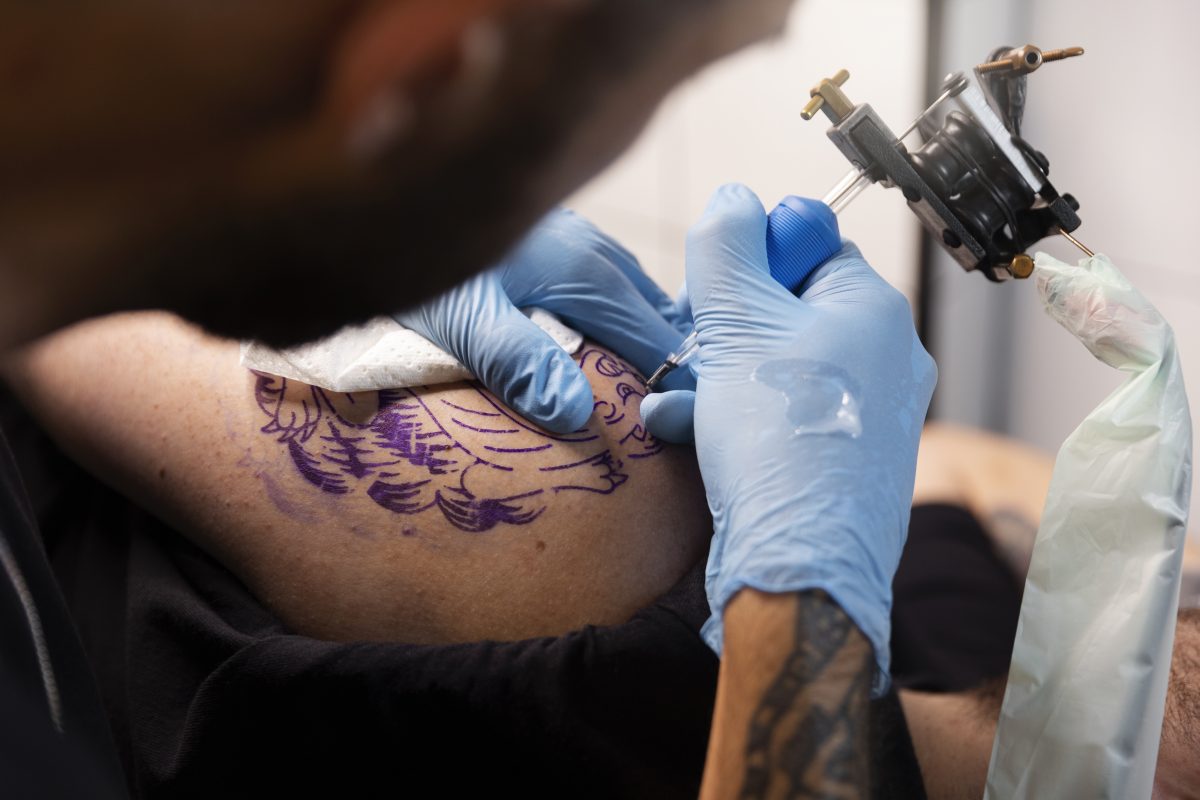Getting Inked with an STD: Risks and Precautions
Is it responsible to get a tattoo if you’re living with an STD? This is a crucial question that deserves a thoughtful approach.
Before committing to new ink, individuals should fully understand the implications of tattooing on their health and safety – particularly if an STD is involved.
Understanding STDs and Tattoos
When considering a tattoo, individuals with STDs must be cognizant of the potential risks to themselves and their tattoo artist. It’s imperative to disclose any STDs to the tattoo professional prior to the procedure to ensure appropriate safety protocols are observed. This openness allows for the maintenance of a sterile environment, reducing the chance of infection or transmission.
Proper sterilization techniques and the use of single-use, disposable needles are critical components in preventing cross-contamination. Awareness and adherence to these standards are paramount for those with STDs seeking tattoos, safeguarding all parties involved in the tattooing process.
Risks of Getting Tattooed with an STD
Engaging in tattooing while living with an STD introduces concerns surrounding infection control, particularly for conditions with bloodborne transmission pathways. Not only does the individual need to be aware of their own health, but they also must consider the well-being of the tattoo artist and other clients.
An STD, depending on its nature, may exacerbate the risk of secondary infections. This is due to possible immune system compromise, which may lead to prolonged healing of the tattooed area, increasing susceptibility to complications, including bacterial infections at the tattoo site. Modern tattoo practices mitigate risks with rigorous hygiene.
Understanding the dynamics of one’s STD is crucial when deciding to get tattooed. For instance, those with viral infections like hepatitis or HIV must be especially vigilant. These conditions pose a risk of transmission if proper protocols are not followed, emphasizing the significance of professional standards within tattoo establishments.
High-Risk STDs for Tattoo Procedures
Certain sexually transmitted diseases (STDs) carry a higher risk of complications during tattoo procedures.
- HIV/AIDS: Immune system compromise can lead to increased infection risk.
- Hepatitis B: A highly contagious virus that can survive outside the body for at least 7 days.
- Hepatitis C: No vaccine is available, and it’s known for its potential for chronic infection.
When considering a tattoo, disclose any high-risk STD to your tattoo professional. Strict sterilization protocols are essential to prevent cross-contamination and disease transmission.
Tattoo Artist Considerations
When seeking a tattoo, it is incumbent upon the client to ensure the artist is informed about their STD status. This transparency is critical for fostering a safe environment for both parties. It necessitates the use of robust, pathogen-specific protocols, for safeguarding against unintended transmission. Importantly, reputable tattoo artists will possess an in-depth understanding of infectious diseases and their modes of transmission.
Tattoo professionals must exercise the utmost caution and employ comprehensive sterilization tactics. This includes the utilization of disposable needles and ink pots, rigorous cleaning schedules, and adhering strictly to universal precautions tailored to prevent the transmission of pathogens.
Disclosure and Confidentiality
It is paramount to exercise transparency regarding your STD status with a tattoo professional. Prioritizing this disclosure ensures that adequate preparations and protocols can be employed to maintain a sterile environment. In certain jurisdictions, concealing a transmittable STD might lead to legal ramifications, making honesty not only a matter of ethics but also of compliance with the law.
Adhering to proper disclosure practices not only protects the safety of the tattoo artist but also the broader public. Any responsible tattooing establishment will have confidentiality protocols in place, upholding discretion while also taking the necessary steps to prevent the risk of cross-contamination or transmission of the STD in question.
Upon disclosure, a professional tattoo artist may request additional information about the STD, including its nature and status of treatment, if any. This allows the practitioner to adjust safety measures according to the level of risk associated with the particular infection, ensuring they can provide their service without compromising health standards.
Tattoo studios are bound by strict privacy policies that are designed to protect clients’ personal health information. Artists are trained to comply with regulations akin to those in medical settings, which means that your STD status should remain confidential, in accordance with legal and ethical guidelines. It’s crucial that mutual trust is established to facilitate a secure and professional tattooing experience.
Ultimately, when a client discloses an STD, the tattoo artist will align their practices with the overarching goal of preventing disease spread. By adhering to confidentiality, clients can feel confident in receiving service from tattoo establishments while respecting the health and safety of all parties involved.
Hygiene Standards in Tattoo Parlors
Extreme cleanliness is the cornerstone of every reputable tattoo establishment. Prioritizing hygiene is imperative to prevent cross-contamination and infection.
In compliance with health regulations, parlors must sterilize equipment using autoclaves, use disposable supplies, and maintain a sterile environment. Staff are rigorously trained in these sterilization protocols to uphold the highest standards of hygiene.
Gloves are mandatory during all tattooing procedures, effectively creating a barrier against transmission of pathogens. Regardless of a client’s health status, these practices are strictly followed to protect both the client and the artist.
Additionally, surfaces and workstations are disinfected with medical-grade solutions after each use. This mitigates risks of skin infections, including those unrelated to transmissible diseases.
Client safety is paramount; thus, transparency about health guidelines is encouraged. Patrons should feel empowered to inquire about a parlor’s sterilization process and observe the hygiene protocols in action.
Pre-Tattoo Medical Advice
Individuals contemplating the acquisition of a tattoo should inform their tattoo artist about their STD status. Disclosure allows for tailored precautionary measures to be implemented, thus safeguarding both the artist and client. Professionals can provide counsel on the safest course of action, which may involve postponing the tattooing process depending on the state and transmissibility of the infection.
Adherence to medical advice and treatment regimens is essential before proceeding with tattooing. Effectively managing the STD can reduce potential complications and promote better healing outcomes. Clients with suppressive therapy for chronic viral infections, such as herpes or human immunodeficiency virus (HIV), should comply with their prescribed medications to mitigate health risks during the tattooing process.
Consulting with Healthcare Providers
Prior to tattooing, consultation with a healthcare provider is imperative. Discussing current health status, including any STDs, can provide critical insights into potential risks associated with tattooing.
When deciding to get a tattoo, it is essential to fully disclose your STD status to a healthcare provider, who can offer personalized advice. Depending on the infection, the healthcare provider might suggest antiviral or antibacterial treatments to minimize the chance of transmission or exacerbation. In some cases, postponement of the tattoo may be prudent until the infection is fully treated or better managed.
Furthermore, a healthcare provider can offer vaccination options for certain preventable STDs, such as hepatitis B. This vaccination, administered prior to tattooing, can confer protection against a virus that could potentially be transmitted through the tattooing process due to blood exposure.
Ultimately, engaging in a dialogue with healthcare providers ensures that a comprehensive risk assessment is undertaken. They can elucidate the relationship between the specific STD and the tattooing procedure, identifying any contraindications or necessary precautions. This is vital in protecting one’s health and the health of the tattoo artist, ensuring that the tattoo experience is as safe as possible for all parties involved.
Timing Your Tattoo Around Treatment
When contemplating acquiring a tattoo, it is paramount to first appraise the status of any STD treatment. Ongoing therapy may necessitate a delay to reduce complications and promote optimal healing.
Accurate synchronization of treatment completion and tattooing is crucial for health safety. Moreover, for certain infections, it’s vital to await the clearance or significant suppression of the pathogen before considering a tattoo. This may involve a series of medical evaluations to confirm whether the STD is under effective control.
In situations where a chronic or incurable STD is present, it is essential to evaluate whether any potential interactions could intensify during the tattoo healing process.
Lastly, do not forget to communicate your health status with your chosen tattoo artist. Transparency regarding your STD condition can influence essential precautionary measures and scheduling.
Aftercare and Infection Prevention
It is absolutely imperative that after receiving a tattoo, individuals follow stringent aftercare protocols. This involves regular cleaning with an antimicrobial soap, applying appropriate topical agents, and avoiding soaking the tattooed area. It’s also essential to keep the area well-moisturized and protected from direct sunlight, which can impede the healing process and potentially exacerbate any existing infections.
Effective aftercare is paramount in defending against the introduction of new pathogens into the tattoo site. Vigilant observation for signs of infection, such as redness, swelling, or abnormal discharge, is critical. Immediate consultation with a healthcare provider is advised should any such symptoms emerge.
Post-Tattoo Care with an STD
Good aftercare is crucial for tattoo healing, particularly when an STD is present. Ensure the tattoo site is always clean and dry. Strict adherence to aftercare instructions is doubly important for those with an STD to prevent complications. This includes avoiding touching the area with unclean hands and ensuring bandages are sterile.
Maintaining a strong immune system supports efficient healing. Nutritious foods, adequate hydration, and proper sleep can all contribute to optimal recovery when managing an STD.
Antiretroviral therapy for individuals with HIV or appropriate medication for other STDs must continue uninterrupted. Consult your healthcare provider regarding any concerns about interactions with aftercare treatments.
Watch for uncommon symptoms around the tattoo site, and if there’s any concern, seek prompt medical attention without hesitation. Early intervention is key to managing complications.
Signs of Tattoo-Related Infections
Recognizing the onset of a tattoo-related infection is imperative for timely and effective treatment.
- Persistent redness around the tattoo site that does not subside or worsens over time.
- Swelling that extends beyond the tattooed area and is disproportionate to the normal inflammatory response expected after tattoo placement.
- Warmth emanating from the tattooed area, indicative of inflammation or infection.
- Pus drainage from the tattoo, which may be opaque, colored, and often accompanied by a foul odor.
- Pain or tenderness that persists or escalates instead of gradually diminishing.
- Fever or chills, as systemic responses to infection, suggesting that the infection may be spreading beyond the tattoo site.
- Red streaks or a worsening rash spreading from the tattoo, which could be signs of a more serious infection, such as cellulitis.
It is essential to monitor for these symptoms closely during the entire healing process. Swiftly seek medical attention if any of these symptoms are observed, as they might require antibiotic intervention or other medical therapy.
Secure and Confidential
STD testing services
The fastest results possbile - available in 1 to 2 days

Tagged
Categorized As
Author: STD Check Editorial Team
At STDCheck.com, we go to great lengths to ensure quality content. We’re using our own collection of data. It is not bought or made up for “click-bait” purposes. We don’t entice traffic with cheesy graphics or raunchy headlines. Our information is to promote STD testing, educate people, let go of social stigmas, and bring awareness. We also provide a completely confidential atmosphere through private testing. When we produce an article, it is fact-based. We check it with medical advisors that approve it. Our staff consists of doctors and other medical professionals who peer review the content we make available on STDCheck.com. From all over the world, we have sourced the best and the brightest content developers, including medical professionals, marketing engineers, data scientists, content specialists, and media relations.




